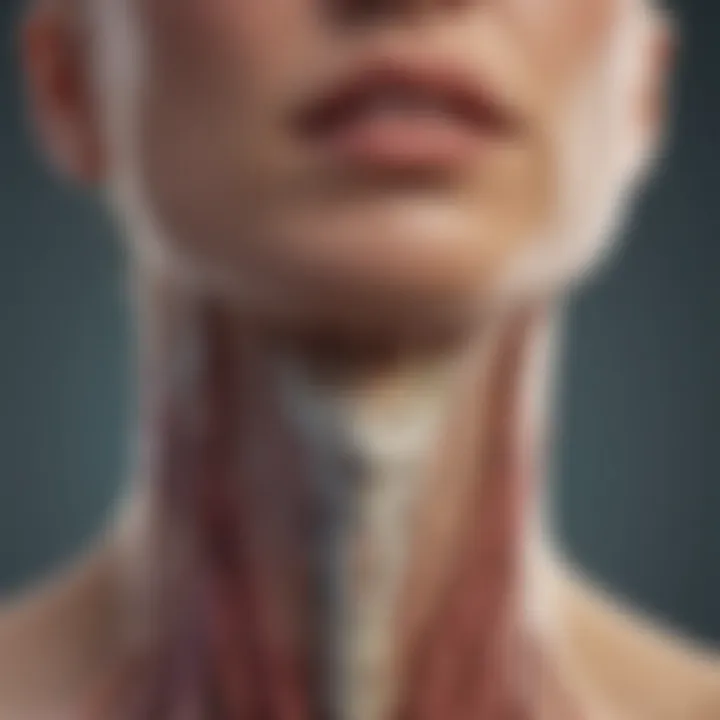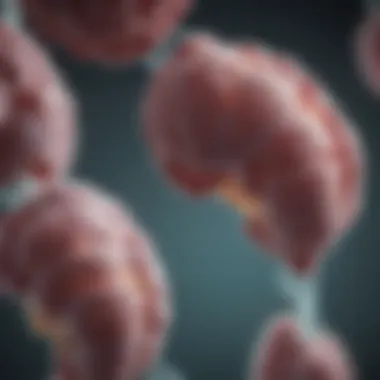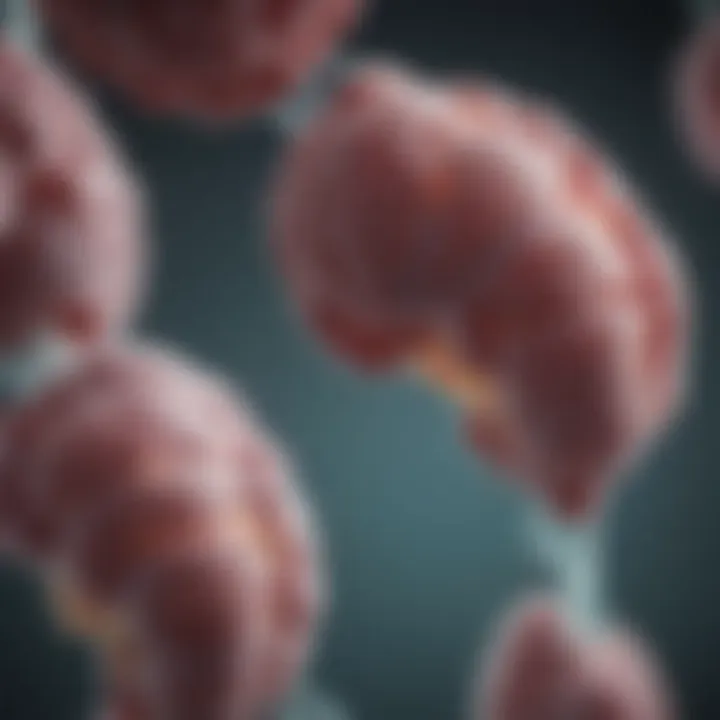Thyroid Papillary Carcinoma: Insights and Treatment


Research Overview
Summary of Key Findings
Papillary Thyroid Carcinoma (PTC) is a form of thyroid cancer that has surged in diagnosis rates over the last few decades. Researchers have pinpointed several key factors that contribute to both its onset and the ways in which it can be effectively treated. Notably, PTC reflects a typically favorable prognosis compared to other thyroid cancers, yet the complexity surrounding its genetic mutations and environmental influences calls for a deeper understanding. One significant finding is the connection between specific genetic alterations, such as those in the BRAF gene, and poor prognostic indicators. Furthermore, the role of environmental risk factors, including radiation exposure, is still under scrutiny, making it essential to explore these elements in detail.
Background and Context
To fully grasp the nuances of PTC, it’s crucial to understand the thyroid’s role within the endocrine system and the specific characteristics that define this cancer type. The thyroid, a butterfly-shaped gland in the neck, regulates various bodily functions by producing hormones. Papillary Thyroid Carcinoma arises from follicular cells and may spread to lymph nodes in the neck, making early detection paramount.
Through the years, the rise in PTC cases has led to speculations surrounding its over-diagnosis, particularly due to advancements in imaging technologies. Studies reflect that while many cases may be incidental findings, the psychological and physical toll on patients cannot be underplayed. Considered the most common type of thyroid cancer, it accounts for an estimated 80% of all cases. This background sets the stage for understanding treatment protocols and survivorship plans moving forward.
Methodology
Experimental Design
Research into PTC has predominantly employed a combination of clinical, genetic, and epidemiological studies. Researchers utilize cohort studies that track populations over time to establish links between risk factors and outcomes. Additionally, laboratory-based experimental studies allow for the examination of tissue samples to analyze genetic mutations and identify potential biomarkers.
Data Collection Techniques
Data related to PTC can be collected from a variety of sources:
- Patient Registries: Information about diagnosed individuals is compiled, yielding insights into demographics and therapeutic responses.
- Biopsy Samples: Histopathological evaluations of tissue are conducted to determine the extent and nature of the carcinoma.
- Genetic Testing: Recent advancements have enabled the examination of mutations in genes like BRAF and RAS that can further elucidate treatment decisions.
Gathering this data forms the backbone of understanding PTC's clinical behavior. Emphasis is placed on compiling a broad spectrum of both quantitative and qualitative data to paint a comprehensive picture of patient outcomes and treatment effectiveness. This interdisciplinary approach ensures that the research is robust, reflecting real-world challenges faced by patients and healthcare providers alike.
Early detection and a multidisciplinary approach are vital in managing Papillary Thyroid Carcinoma, ensuring patients receive the best possible outcomes.
Foreword to Thyroid Anatomy and Function
Understanding the intricacies of thyroid anatomy and function is crucial when discussing Papillary Thyroid Carcinoma (PTC). The thyroid gland, small yet powerful, plays a significant role in various metabolic processes that govern our body's homeostasis. By grasping how this gland works, we can better appreciate how disruptions, like cancer, can interfere with our physiology.
The thyroid gland is strategically located at the base of the neck. It resembles a butterfly, sprawling across the trachea, with two lobes linked by a thin strip known as the isthmus. This unique structure is not just for looks; it functions as the production house for key hormones that control metabolism, growth, and development. With its rich vascularization and intricate cellular architecture, any abnormality within this gland can have profound implications, especially in the context of cancer.
The importance of the thyroid gland extends beyond merely producing hormones. It is also linked to broader endocrine functions, influencing everything from heart rate to body temperature regulation. Each aspect of its anatomy serves a purpose, making the understanding of thyroid functions essential, particularly for early detection and management of conditions like PTC.
"The thyroid is a master regulator of metabolism, but its subtlety can be easily overlooked until something goes amiss."
Overview of the Thyroid Gland
The thyroid gland is comprised of follicular cells that synthesize and secrete two primary hormones: thyroxine (T4) and triiodothyronine (T3). These hormones are pivotal in regulating metabolism; they control how the body uses energy. A well-functioning thyroid can be likened to a finely tuned engine, with T3 and T4 acting as the fuel. However, when aspects of the gland's function become dysfunctional, it can lead to various metabolic disorders or, in worse cases, cancers.
The gland also contains parafollicular cells, which are responsible for producing calcitonin—a hormone that helps in regulating calcium levels in the body. An imbalance in the amounts of these hormones can lead to symptoms ranging from fatigue and weight gain to unexpected weight loss, all of which may signal underlying issues that require further investigation, like PTC.
Hormonal Role in Metabolism
The hormones produced by the thyroid have a widespread impact on almost all bodily systems, due to their role in regulating metabolism. Thyroid hormones help in the conversion of oxygen and calories into energy—a fundamental process enabling every activity in our daily lives.
- Energy Regulation: By adjusting the rate at which we burn calories, hormones like T3 and T4 dictate how energetic we feel and how effectively we can carry out physical activities.
- Growth and Development: In children, adequate levels of thyroid hormones are essential for proper growth and development. A deficiency can manifest as growth retardation and other developmental issues.
- Heart Function: These hormones affect how fast the heart beats. An overproduction can lead to increased heart rates (tachycardia), while too little can result in a slowed heart rate (bradycardia).
- Temperature Regulation: The thyroid hormones influence our body’s heat regulation. A person with hyperthyroidism may feel overly hot, while someone with hypothyroidism may feel cold.
Understanding these roles helps emphasize why early detection of thyroid issues is critical. When the thyroid is not functioning correctly, particularly in cases of PTC, the resulting hormonal imbalance can have far-reaching effects—making it imperative that we grasp the nuances of this gland and its functions.
Understanding Papillary Thyroid Carcinoma
Understanding Papillary Thyroid Carcinoma (PTC) is crucial not only for medical professionals but also for students and the general public interested in thyroid health. This type of thyroid cancer, which often bears a favorable prognosis, has been making waves due to its increasing incidence in recent years.
An essential ingredient in grasping PTC is recognizing how common it is, especially when compared to other thyroid malignancies. This cancer type represents about 80% of all thyroid cancers, making it a significant player in the world of endocrine oncology. What sets PTC apart is its characteristic growth behaviors and typically slow progression, allowing for relatively effective treatment options if detected early.
Definition and Classification
Papillary Thyroid Carcinoma is a malignancy that arises from the thyroid follicular cells, built up as a series of small, well-defined tumor nodules. It stands out in the classification of thyroid cancers due to its multifocal nature, commonly manifesting as multiple cancerous nodules in one or both lobes of the thyroid.
This carcinoma can be further classified into various types based on distinct histopathological features:
- Classic Variant: The most common form, characterized by papillae and large nuclei.
- Follicular Variant: Mimics follicular adenomas, creating a diagnostic challenge.
- Tall Cell Variant: Associated with more aggressive outcomes due to higher mitotic activity.
- Diffused Sclerosing Variant: Often seen in younger individuals, presenting distinct clinical features.
Understanding these classifications helps tailor the approach to treatment based on specific tumor characteristics and patient's personal health conditions.


Epidemiology of PTC
The epidemiology of Papillary Thyroid Carcinoma reveals significant trends and patterns.
- Incidence Rates: There has been a noticeable rise in PTC cases, particularly in women, showing rates that are three times higher than in men. This increase can often be attributed to heightened awareness and improved diagnostic techniques, but some experts also point towards environmental factors and changes in lifestyle.
- Geographic Variations: PTC is particularly prevalent in regions like North America and certain areas of Asia, notably Japan, where routine screenings have led to early detection practices.
- Age Considerations: The age of onset varies significantly. While it can appear in younger individuals, peaks in diagnosis typically occur in the 30 to 50-year age range.
Understanding these epidemiological aspects plays a critical role in upholding the importance of awareness initiatives around thyroid cancer, especially tailored towards specific populations and genders vulnerable to its detrimental effects.
Pathophysiology of Papillary Thyroid Carcinoma
The pathophysiology of Papillary Thyroid Carcinoma (PTC) serves as a foundation for understanding how this particular type of thyroid cancer develops and manifests in patients. It’s crucial to appreciate these mechanisms, as they provide insights that shape both diagnosis and treatment strategies. Within this framework, elements such as cellular origin and genetic mutations play pivotal roles.
Cellular Origin and Characteristics
Papillary Thyroid Carcinoma primarily arises from the follicular cells in the thyroid gland. These cells are responsible for synthesizing thyroid hormones, which regulate various bodily functions. In PTC, there’s an aberration in the normal development and function of these cells.
The characteristics of PTC are distinctive. Often, the tumors are slow-growing, and despite their malignancy, they frequently exhibit a low rate of metastasis. This might seem counterintuitive, but such behavior can complicate early detection. While they can spread, particularly to lymph nodes, many cases are indolent, meaning that patients could live for years without significant health risks, leading to a possible underestimation of the disease's severity.
Some clinical observations have noted that PTC commonly appears as a solid or cystic mass on ultrasound. Additionally, the encapsulated nature of these tumors can aid in surgical interventions, making them somewhat more manageable compared to other thyroid cancer types, provided they are detected early.
Genetic Mutations Involved
Moving deeper into the molecular underpinnings, genetic mutations are a significant aspect to consider. They provide a clearer picture of the carcinogenic processes at play in PTC. Some key mutations linked to PTC include BRAF mutations and RET/PTC rearrangements.
BRAF Mutations
BRAF mutations, especially the V600E variant, have garnered substantial attention due to their prevalence in PTC cases. This mutation contributes to the activation of the MAPK signaling pathway, which in turn drives cellular proliferation and survival. Its presence can serve as a marker for diagnosis, playing a role in how aggressive the cancer may become.
A striking feature of BRAF mutations is their association with more aggressive forms of PTC. Many studies have indicated a correlation between this mutation and poorer prognostic outcomes, which highlights the need for early intervention and tailored treatment plans. However, the detection of BRAF mutations also opens the door for targeted therapies, offering a way forward for patients who may be facing more severe progression of their disease.
RET/PTC Rearrangements
On the other hand, RET/PTC rearrangements are also critical in understanding PTC. These genetic alterations lead to the fusion of RET oncogenes with various partners, ultimately activating signaling pathways that result in oncogenesis. RET/PTC rearrangements are often found in cases of PTC associated with radiation exposure.
The unique feature of RET/PTC rearrangements is their relatively distinct origin—a significant number arise from childhood exposure to ionizing radiation, particularly from therapeutic radiation. This factor underlines the importance of patient history when diagnosing PTC and tailoring prevention strategies. While these rearrangements are less common than BRAF mutations, they provide valuable insights into the cancer's biological behavior and potential responses to therapy.
Understanding these genetic characteristics not only informs clinicians about potential treatment pathways but also enhances predictive capabilities regarding patient prognosis and survival rates.
In summary, the pathophysiology of Papillary Thyroid Carcinoma plays a multi-faceted role in diagnosis and treatment, interlinking genetic features and tumor behaviors. Recognizing the nuances behind cellular origin and genetic mutations is vital for developing effective management strategies for patients diagnosed with this cancer.
Diagnostic Approaches for PTC
In the realm of detecting Papillary Thyroid Carcinoma (PTC), the significance of diagnostic strategies cannot be overstated. The earlier this cancer is identified, the better the prognostic outcomes tend to be. As important as a watchful eye is in noticing worrisome signs, a systematic approach through various diagnostic methods forms the backbone of effective PTC management. These methods aim to confirm a diagnosis, evaluate tumor characteristics, and ultimately guide treatment decisions.
Clinical Presentation and Symptoms
Papillary Thyroid Carcinoma often presents in subtle ways that can easily be missed in routine examinations. The most notable symptom is the presence of a nodule in the thyroid gland, usually identified during a physical examination. Other potential symptoms can include:
- Swelling in the neck: This might feel like a lump and is often the first noticeable change.
- Changes in voice: A hoarse voice can occur if the tumor presses on surrounding structures.
- Difficulty swallowing: If the tumor grows large enough to obstruct the esophagus, it can lead to swallowing challenges.
- Enlarged lymph nodes: There can be noticeable swelling in lymph nodes around the neck, indicating that the cancer may have spread.
These symptoms, while ranging from benign to alarming, highlight the necessity for thorough evaluations and diagnostic imaging to ascertain the nature of thyroid nodules.
Imaging Techniques
Ultrasound
Ultrasound stands out as a cornerstone in the evaluation of thyroid nodules. It is notably non-invasive and does not involve radiation, making it an optimal initial imaging method. The most distinguishing aspect of ultrasound lies in its ability to provide real-time imaging and detailed characteristics of thyroid masses, such as their size, texture, and whether they have suspicious features like microcalcifications or irregular borders.
- Benefits: The key advantages are its accessibility and sensitivity in identifying nodules as well as the capacity to guide fine needle aspiration biopsies for cytological analysis.
- Disadvantages: However, ultrasound cannot definitively diagnose malignancy; it can signal the need for further evaluation but falls short of providing a conclusive answer regarding cancer presence.
CT Scan
Computed Tomography scans serve as a valuable tool, especially in cases where there is a need to evaluate the extent of the disease. One of the key characteristics of CT scans is their high spatial resolution, making it possible to visualize surrounding tissues and lymph nodes effectively. This imaging method is particularly beneficial when assessing larger masses or suspecting extrathyroidal extension, giving clinicians vital information to tailor surgical approaches.
- Benefits: The level of detail provided in these images aids in surgical planning.
- Disadvantages: On the downside, the exposure to ionizing radiation and the use of contrast medium can pose risks to certain patients, especially in younger populations or those with contraindications to contrast agents.
PET Scan
Positron Emission Tomography scans come into play mainly in advanced cases or when there is suspicion of recurrence after initial treatment. PET scans are intriguing for their ability to illustrate metabolic activity, which can signal areas of cancerous activity even when structural changes might not yet be apparent.


- Benefits: The unique feature of PET scanning is its capacity to detect malignancies with a higher sensitivity, allowing for earlier detection of potential metastasis.
- Disadvantages: Conversely, their limited availability and higher cost, coupled with the potential for false positives, can be challenging in routine diagnostic use.
Histopathological Examination
Histopathological examination involves analyzing biopsied tissue under a microscope and remains the gold standard in diagnosing PTC. This process enables definitive classification of the cancer type and can reveal the presence of distinct cellular features that define papillary thyroid carcinoma. Pathologists look for the typical patterns and markers associated with PTC, providing the critical confirmation needed to guide treatment decisions effectively.
Performing histopathology can guide the multidisciplinary team in customized patient management, thereby improving outcomes.
Treatment Strategies for Papillary Thyroid Carcinoma
Understanding the treatment strategies for papillary thyroid carcinoma (PTC) is crucial, as it shapes the course of care for patients facing this condition. Given the diverse nature of PTC, various treatment options are available, each tailored to specific patient needs and tumor characteristics. The primary aim is to eradicate cancer while preserving thyroid function and minimizing complications.
Within this realm, surgical interventions, radioactive iodine therapy, and targeted therapies play distinct yet complementary roles. These strategies not only aim for immediate control of the disease but also minimize the risk of recurrence, highlighting the importance of a comprehensive treatment approach.
Surgical Interventions
Thyroidectomy
Thyroidectomy is a surgical procedure that entails the removal of all or part of the thyroid gland. It's often the cornerstone treatment for PTC. The key characteristic of thyroidectomy lies in its ability to provide a direct solution to the tumor by excising tumor-bearing tissue. This approach is particularly beneficial as it can lead to an increased likelihood of the patient being cancer-free post-operation.
One unique feature of thyroidectomy is its adaptability; depending on the size and extent of the tumor, either a total or partial thyroidectomy may be performed. However, with surgery comes the possibility of complications, such as changes in hormone levels and damage to surrounding structures, including the recurrent laryngeal nerve.
Lymph Node Dissection
Lymph node dissection is another vital surgical approach often employed alongside thyroidectomy, especially in cases where the cancer has spread. This procedure involves the removal of lymph nodes that may harbor cancer cells. The key characteristic of lymph node dissection is its dual role: not only does it assist in staging the cancer, but it also reduces the risk of recurrence.
A notable advantage of lymph node dissection is its potential to provide a thorough assessment of cancer spread. Nonetheless, it may also lead to postoperative complications like lymphedema and increased surgical time, necessitating careful deliberation and discussion between the patient and the surgical team.
Radioactive Iodine Therapy
Radioactive iodine therapy is often utilized following surgery, particularly in patients with a high risk of disease recurrence. The primary aspect of this treatment is its ability to target residual thyroid tissue or microscopic cancer cells left after surgery.
This therapy is a popular choice because it can minimize the chances of recurrence significantly. It works by delivering a concentrated dose of radiation directly to thyroid cells, which absorb iodine. However, a consideration is the need for preparation before the treatment, including dietary restrictions and hormone withdrawal.
Targeted Therapies
Tyrosine Kinase Inhibitors
Tyrosine kinase inhibitors represent a newer frontier in the treatment of advanced PTC, particularly when conventional therapies have failed. These agents play a crucial role in blocking the signaling pathways that promote tumor growth. Their ability to specifically target genetic mutations found in cancer cells offers promise for more personalized treatment approaches.
The key characteristic of tyrosine kinase inhibitors is their selectivity; they primarily affect cancerous cells while sparing normal cells. This specificity can lead to a decreased incidence of side effects compared to traditional chemotherapy. However, they are not without drawbacks. Common adverse effects include hypertension and gastrointestinal issues, which require monitoring during therapy.
Advances in treatment strategies have revolutionized the management of papillary thyroid carcinoma, providing patients with options that are tailored to their specific cancer characteristics.
In summary, the approach to managing papillary thyroid carcinoma encompasses a range of strategies, from traditional surgical methods to innovative therapies like tyrosine kinase inhibitors. This multifaceted approach not only aims at effective cancer control but also at improving the overall quality of life for patients.
Prognostic Factors in PTC
Understanding the prognostic factors in Papillary Thyroid Carcinoma (PTC) is essential for both clinicians and patients. These factors not only guide treatment decisions but also shape the expectations regarding long-term outcomes. Knowing what influences prognosis could mean the difference between cautious monitoring and aggressive intervention. The nuances behind prognostic indicators offer a clearer picture of the disease’s trajectory.
Staging of Thyroid Cancer
Staging refers to determining the extent of the cancer – how far it has spread in the body and whether it has affected nearby lymph nodes or distant organs. In PTC, the staging system mainly revolves around the size of the tumor, its location, and whether it has metastasized.
- Stage 0 (Papillary Carcinoma in Situ): In this stage, the tumor is confined to the thyroid and has not invaded surrounding tissues. It’s detected very early, usually during exams for unrelated issues.
- Stage I: The cancer is still confined to the thyroid, but it’s larger than 1 cm. It does not affect lymph nodes or distant sites at this point.
- Stage II: At this stage, the tumor is larger than 2 cm and usually invades local structures or nearby lymph nodes but hasn’t spread throughout the body.
- Stage III: Tumors in stage III may have involved nearby lymph nodes or structures but lack distant spread. This is a critical stage indicating a more aggressive nature of the disease.
- Stage IV: This stage divides into IVA, IVB, and IVC, varying in severity. In essence, the cancer could have metastasized to distant organs, making management quite complicated.
This staging system not only helps in making treatment choices but also in predicting outcomes. As they say, "knowing is half the battle," and staging provides a roadmap for expected future developments.
Outcomes and Survival Rates
Evaluating the long-term outcomes and survival rates associated with PTC unveils an optimistic scenario. Statistics suggest that PTC generally has a favorable prognosis, particularly when diagnosed and treated early. The five-year survival rate often exceeds 90% for patients diagnosed at stage I.
However, multiple factors can influence these outcomes:
- Age of the Patient: Patients under 45 years old typically fare better compared to those older than this threshold.
- Tumor Size: Larger tumors tend to correlate with a poorer outcome. Those larger than 4 cm are flagged as higher risk and might attract closer scrutiny.
- Lymph Node Involvement: The presence of cancer in lymph nodes is a red flag. It signifies a more advanced stage and could complicate treatment.
- Histological Variants: Certain histological subtypes of PTC, like tall-cell variant, have been associated with less favorable outcomes compared to classical variants.
"The right data can save lives; understanding survival statistics facilitates informed choices between treatment paths."
In summary, while PTC often presents positive prognostic outcomes, a nuanced approach considers all the influencing factors. This understanding not only aids in individualized treatment plans but also helps in setting realistic expectations for patients and families.


Follow-Up Care for PTC Patients
Follow-up care is one of the pillars when it comes to managing Papillary Thyroid Carcinoma (PTC) successfully. After the initial treatment, which often involves surgery and potentially radioactive iodine therapy, continuous monitoring becomes crucial. The journey does not end with surgery; rather, it unfolds into a systematic follow-up, aiming to catch any recurrence and manage the patient’s thyroid function effectively.
Regular evaluations can assure patients and healthcare providers that the cancer has not returned and that the remaining thyroid tissue is functioning properly. Early detection of any changes is paramount. Monitoring checks allow for timely interventions if abnormalities arise. These aren't just routine visits; they're the backbone of ongoing reassessment of health post-treatment.
Monitoring for Recurrence
Monitoring post-treatment is a fundamental concept for patients recovering from PTC. This entails being vigilant for signs of recurrence through various tests and evaluations.
Thyroid Function Tests
Thyroid Function Tests (TFTs) play a vital role in the follow-up care of patients with PTC. These tests measure the levels of thyroid hormones in the blood, providing insight into how well the thyroid gland is functioning after treatment.
A key characteristic of TFTs is their ability to identify potential issues at an early stage. By frequently monitoring levels of Thyroxine (T4) and Thyroid-Stimulating Hormone (TSH), healthcare providers can adjust treatment plans accordingly. The unique feature of these tests is their straightforward nature; they're relatively non-invasive and can be performed easily in a clinical setting.
However, while TFTs are beneficial, they also have their limitations. They don't directly indicate whether cancer has returned but can provide clues regarding the overall metabolic state of the patient. Hence, the interpretation of these results requires skilled clinical judgment.
Imaging Follow-Up
Imaging follow-up is another crucial aspect of monitoring for recurrence. Different imaging modalities such as ultrasound, CT scans, or PET scans help visualize any structural changes or abnormalities that could signify a recurrence. Regular imaging is often recommended in the surveillance protocol for PTC patients.
A significant characteristic of imaging follow-up lies in its ability to offer a dynamic view of the patient's anatomical status. If scans reveal nodules or unexpected growths, those findings can lead to further investigation quickly. The unique feature here is the visual confirmation, which adds an additional layer of reassurance to both patients and physicians.
Nonetheless, imaging has its trade-offs. Regular scans can lead to increased exposure to radiation, which carries its risks. Evaluating the necessity of imaging at appropriate intervals becomes a balancing act between vigilance and safety.
Long-Term Management Strategies
Long-term management strategies are imperative in the holistic care of PTC patients. These strategies encompass not only physical health monitoring but also emotional support and lifestyle modifications to optimize health outcomes.
Patients ought to be educated on the importance of healthy lifestyle choices. This can include balanced diets, regular exercise, and stress management techniques. Additionally, healthcare providers must facilitate access to support groups or psychological counseling if needed, recognizing that cancer recovery is as much about mental well-being as it is about physical health.
Finally, a robust plan ought to be established for a personalized follow-up schedule. This incorporates both laboratory tests and imaging studies tailored to the individual's risk factors and treatment history. Ensuring clear communication between patients and their medical teams about what to expect during follow-up appointments can be tremendously beneficial.
By focusing on comprehensive follow-up care, patients with PTC can reclaim a sense of control over their health journey and enhance their quality of life.
Research and Future Directions
The dynamic landscape of healthcare is heavily influenced by ongoing research efforts. In the realm of Papillary Thyroid Carcinoma (PTC), research is pivotal. It shapes our understanding of this cancer, its underlying mechanisms, and better treatment options. As the medical community strives to provide enhanced care, it’s paramount to focus on innovative therapeutic strategies and address the often overlooked challenges in current research. This section examines both aspects, shedding light on their relevance in advancing the management of PTC.
Novel Therapeutic Approaches
One cannot ignore the strides being made in novel therapeutic approaches to treat PTC. Advancements in technology and a better understanding of tumor biology have paved the way for treatments that are more targeted and efficient. For instance, tyrosine kinase inhibitors such as Lenvatinib and Sorafenib have shown potential in managing advanced PTC, particularly in cases that do not respond to standard treatments. Additionally, emerging therapies such as immune checkpoint inhibitors augment the immune system’s ability to recognize and combat cancer cells.
A few potential avenues being explored include:
- Immunotherapy: Leveraging the body’s immune system to fight cancer may change how we approach treatment. Early trials indicate that some patients respond quite well.
- Targeted Drug Delivery: Innovations in nanotechnology could allow for more precise delivery of drugs, minimizing side effects while maximizing efficacy.
- Gene Therapy: As we unravel genetic mutations like BRAF and RET/PTC, targeted gene therapies could provide a means to rectify these faulty pathways, representing a shift from conventional pharmacological approaches.
These novel therapies are not just concepts but a reality in various stages of clinical trials. Research has demonstrated a clear need for diverse treatment strategies, as not all patients fit neatly into one mold.
Challenges in Current Research
Even with remarkable progress, various challenges hinder the advancements in PTC research. One critical issue is the heterogeneity of the disease itself. Variability in the genetic makeup and the differing responses to therapies can complicate treatment protocols. This complexity necessitates that researchers adopt personalized treatment approaches, considering the individual variations that exist among patients.
Moreover, funding and resource allocation pose significant barriers to research. Many promising studies lack sufficient financial support to progress beyond initial phases. To further compound the issue, some findings may not be readily applicable in varied populations, limiting the generalizability of new discoveries about PTC. Additionally, translational research—the process of applying lab findings to clinical environments—can face obstacles in scaling and implementation in diverse medical settings.
"The best research is one that bridges the gap between lab discoveries and real-world applications, ensuring that patients reap the benefits of science."
Ultimately, addressing these challenges requires a concerted effort from the entire medical community, including collaboration among institutions, increased funding, and multi-disciplinary approaches to research. Only with these considerations in mind can the future hold significant advancements for PTC management.
The End
The topic of Papillary Thyroid Carcinoma (PTC) encapsulates a crucial aspect of endocrine oncology. This article has aimed to elucidate the complexities surrounding PTC, which is the most commonly diagnosed form of thyroid cancer. Given the rising incidence rates and improving survival outcomes, understanding the nuances of PTC has never been more pertinent.
In closing, we spotlight several key elements that merit consideration. Firstly, the genetic underpinnings of PTC, such as BRAF and RET/PTC mutations, play a significant role in its pathogenesis and present opportunities for targeted therapy. Recognizing these genetic factors allows for a more precise treatment approach, which can enhance patient outcomes.
Furthermore, the importance of early detection cannot be overstated. As noted earlier, patients diagnosed at earlier stages tend to have more favorable prognoses. Thus, increased awareness and regular screenings can impact long-term survival rates positively.
Moreover, the diversity in treatment strategies, ranging from surgical interventions to radioactive iodine therapy and emerging targeted therapies, underscores the need for personalized management plans tailored to individual patient profiles and conditions. In a rapidly evolving medical landscape, it is vital that clinicians stay abreast of novel therapeutic approaches and advancements in diagnostic technologies.
Lastly, long-term follow-up and monitoring strategies are essential. They serve as a backbone in managing potential recurrences effectively while also addressing the psychosocial aspects of coping with cancer. Thus, establishing a well-rounded follow-up care protocol can significantly enhance quality of life for survivors.
"The journey of PTC is multifaceted, involving a balance of genetics, timely intervention, and comprehensive care."
In summary, the exploration of Papillary Thyroid Carcinoma is as much about understanding the disease as it is about recognizing the human element behind the statistics. A holistic approach that marries scientific inquiry with empathetic patient support remains paramount in navigating the future of PTC management.







